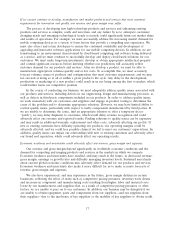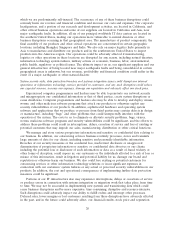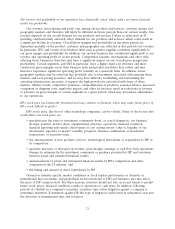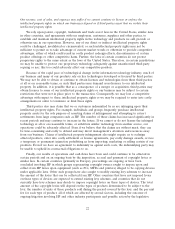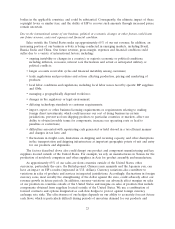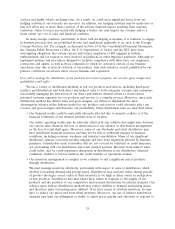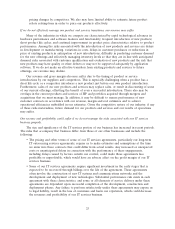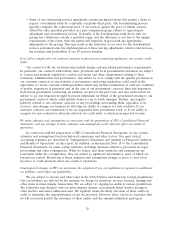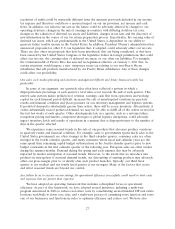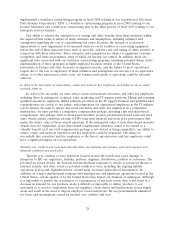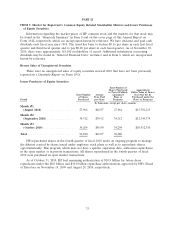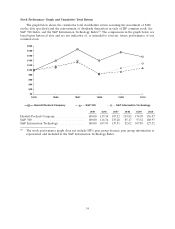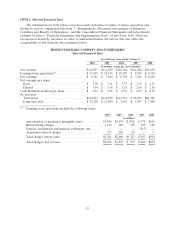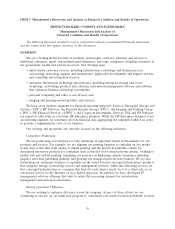HP 2010 Annual Report Download - page 34
Download and view the complete annual report
Please find page 34 of the 2010 HP annual report below. You can navigate through the pages in the report by either clicking on the pages listed below, or by using the keyword search tool below to find specific information within the annual report.• Some of our outsourcing services agreements contain pricing provisions that permit a client to
request a benchmark study by a mutually acceptable third party. The benchmarking process
typically compares the contractual price of our services against the price of similar services
offered by other specified providers in a peer comparison group, subject to agreed upon
adjustment and normalization factors. Generally, if the benchmarking study shows that our
pricing has a difference outside a specified range, and the difference is not due to the unique
requirements of the client, then the parties will negotiate in good faith any appropriate
adjustments to the pricing. This may result in the reduction of our rates for the benchmarked
services performed after the implementation of those pricing adjustments, which could decrease
the revenues and profitability of our IT services business.
If we fail to comply with our customer contracts or government contracting regulations, our revenue could
suffer.
Our contracts with our customers may include unique and specialized performance requirements.
In particular, our contracts with federal, state, provincial and local governmental customers are subject
to various procurement regulations, contract provisions and other requirements relating to their
formation, administration and performance. Any failure by us to comply with the specific provisions in
our customer contracts or any violation of government contracting regulations could result in the
imposition of various civil and criminal penalties, which may include termination of contracts, forfeiture
of profits, suspension of payments and, in the case of our government contracts, fines and suspension
from future government contracting. In addition, we have in the past been, and may in the future be,
subject to qui tam litigation brought by private individuals on behalf of the government relating to our
government contracts, which could include claims for up to treble damages. Further, any negative
publicity related to our customer contracts or any proceedings surrounding them, regardless of its
accuracy, may damage our business by affecting our ability to compete for new contracts. If our
customer contracts are terminated, if we are suspended from government work, or if our ability to
compete for new contracts is adversely affected, we could suffer a reduction in expected revenue.
We make estimates and assumptions in connection with the preparation of HP’s Consolidated Financial
Statements, and any changes to those estimates and assumptions could adversely affect our results of
operations.
In connection with the preparation of HP’s Consolidated Financial Statements, we use certain
estimates and assumptions based on historical experience and other factors. Our most critical
accounting estimates are described in ‘‘Management’s Discussion and Analysis of Financial Condition
and Results of Operations’’ in this report. In addition, as discussed in Note 18 to the Consolidated
Financial Statements, we make certain estimates, including decisions related to provisions for legal
proceedings and other contingencies. While we believe that these estimates and assumptions are
reasonable under the circumstances, they are subject to significant uncertainties, some of which are
beyond our control. Should any of these estimates and assumptions change or prove to have been
incorrect, it could adversely affect our results of operations.
Unanticipated changes in HP’s tax provisions, the adoption of new tax legislation or exposure to additional
tax liabilities could affect our profitability.
We are subject to income and other taxes in the United States and numerous foreign jurisdictions.
Our tax liabilities are affected by the amounts we charge for inventory, services, licenses, funding and
other items in intercompany transactions. We are subject to ongoing tax audits in various jurisdictions.
Tax authorities may disagree with our intercompany charges, cross-jurisdictional transfer pricing or
other matters and assess additional taxes. We regularly assess the likely outcomes of these audits in
order to determine the appropriateness of our tax provision. However, there can be no assurance that
we will accurately predict the outcomes of these audits, and the amounts ultimately paid upon
26



